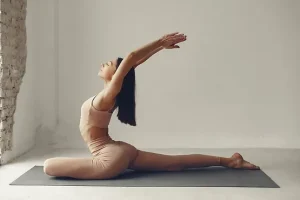Yoga is an interrelated set of mind-body exercises, mental, physical, and spiritual practices that originate in ancient India. Yoga combines meditative disciplines, body postures, and breathing exercises to create a union between mind, body, and spirit. Yoga is one of the eight orthodox spiritual traditions in Hinduism. The word Yoga comes from the Sanskrit words “yuj” meaning “to unite,” “tha” meaning “forth”, and “ruggi” meaning “to stretch.” Yoga’s roots can be traced as far back as the 3rd century BC in India.
The history of yoga is complex, involving a development of diverse practices across many geographical areas and times. The word Yoga ultimately evolved into two forms, the first being Hatha Yoga, which emphasized meditation, spiritual reading, and relaxation. It was popular among people who were involved with sports, such as athletes, mountaineers, and wrestlers. Modern Hatha Yoga combines meditation with physical movements and can be practiced by individuals of any age, but especially by those who want to strengthen their muscles and mind. In addition to strengthening Yoga’s physical benefits, Yoga can also help with depression, anxiety, chronic pain, and other ailments. For example, Yoga can help you overcome back pain, headaches, poor balance and coordination, asthma, heart problems, insomnia, and many other health conditions.
The most common pose for Yoga, which is also the most common pose for Yoga beginners, is the chair pose. This is the simplest pose to learn, although many students may feel intimidated by it at first because the poses are sometimes difficult to execute, and because the body needs to stay still for the entire duration of Yoga. The basic yoga postures are based on alignment and proper breathing, which are integral components of Yoga. To begin Yoga, you simply sit down, cross your legs under your thighs, and curl your upper body forward until your buttocks are parallel with the floor. This simple sitting posture will serve to increase your physical energy and stabilize your body’s internal organs.
Another popular pose for Yoga beginners is the triangle pose, which is performed by stretching the triangle form a triangle with your hands pointing upwards. You may hold the triangle as if it were a small, sharp sword, or you may use your fingers to create an actual sword with your hands. As you twist the triangle in the air, you’ll focus only on how your arms and legs move, and you’ll become aware of your breathing techniques. You may find that the quality of your Yoga practice improves when you learn to meditate after completing the triangle pose. By learning and executing the basic Yoga postures, you can increase your strength and flexibility, improve your mental balance, and develop a strong sense of self.
The term “yoga” originates from the Sanskrit word “yug” (meaning to unite). The term has also come to refer to a particular philosophy or tradition of Hinduism, Buddhism, Jainism, and Sikhism. There are varying views regarding the origin of yoga and its meaning. Some people believe that it originated in India, while others think it originated in ancient Greece. According to the commonly accepted history, yoga emerged from the teachings of Patanjali, who was a Brahmin in the Indus Valley Civilization.
In addition to the traditional Yoga asana, which is performed in class, you can take up Hatha yoga postures to deepen your mind and muscles. There are many different styles of Hatha yoga, including relaxation and meditation. Hatha Yoga is characterized by controlled breathing, relaxed and comfortable postures, and a strong sense of spiritual connection. To make sure that you’re practicing Yoga correctly, it helps to know whether or not it fits your individual needs; whether you want to meditate or perform any other Yoga technique.





